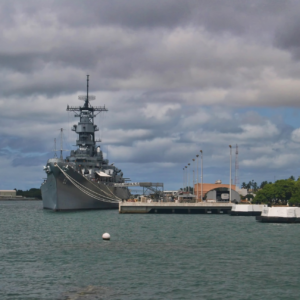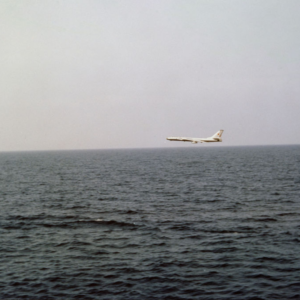In 1937, the German Air Ministry issued a specification for a single-engine three-seat short-range reconnaissance and observation aircraft, with the emphasis on good all-round visibility. The requirement drew responses from Arado and Focke Wulf, in addition to the novel approach of Blohm und Voss’ Richard Vogt, then head of Hamburger Flugzeugbau, which Blohm und Voss had recently purchased.

Blohm und Voss was primarily known at the time for building flying boats. The unorthodox design of the Bv-141, however, featured an asymmetric layout — a single radial engine was installed at the forward end of a port-side tail boom, with the extensively windowed crew nacelle mounted to starboard. The Air Ministry was predictably appalled by this strange configuration and refused to approve a single example for production. When the design was submitted, there were scowls and snickers and suggestions that Blohm und Voss should stick to flying boats.
WAS THE BV-141 THE FIRST ASYMMETRICAL PLANE?
The concept of an asymmetric aircraft actually dates back to World War I. Designs such as the Gotha G.VI, built in 1918, were intended to provide their crews with a better view and a heavier concentration of firepower. But the Gotha design saw little development and never went into production.
The plane that emerged from Vogt’s concept, the Bv-141 was remarkably aerodynamic even though it was undoubtedly the most unorthodox-looking aircraft constructed during World War II. It was 39 feet, 10 inches long, with a wingspan of 50 feet, 8 inches and weight of 8,600 pounds, putting it in almost the same size and weight class as the Messerschmitt Bf-110.
Powered by a 865-hp BMW 132 radial engine, the Bv-141 had a respectable (for 1938) top speed of 248 mph and a ceiling of 29,530 feet, while its 700-mile range was almost twice that of its closest competitor, the Focke Wulf Fw-189. The Fw-189 was a light twin-engine aircraft intended to give maximum possible visibility to the observer. The cockpit was completely windowed and formed a single transparent shell; the tail section was a twin-boom configuration like the Lockheed P-38’s, which made for a wide field of visibility toward the rear. Flight stability, especially at lower speeds, was almost ideal for observation purposes. Most Air Ministry officials preferred the Fw-189.

WAS THE BV-141 A FAILURE?
Many analysts look back on the Bv-141 as the most remarkable aircraft of WWII, but they generally regard it as a failure. It was indeed remarkable, but it wasn’t a failure. The plane initially was good — better than the Fw-189. But the design team simply ran into too much opposition from the Air Ministry in the course of development. More asymmetric designs were subsequently proposed, but they never came into being before the war ended and the design team was dispersed.
In 1943 Vogt was permitted to develop a dive-bomber and attack aircraft, the Bv-237, around the same concept. That aircraft featured an armored fuselage nacelle and would have carried only a pilot in the dive-bomber configuration, but a pilot and a tail gunner in the attack configuration. In the latter version, the armament included three 30 mm MK 103 cannons, along with two fixed 13mm MG 131 machine guns and a pair of similar weapons for the tail gunner. The B-1 series was anticipated to have an auxiliary turbojet engine under the fuselage. Although design work reached an advanced stage, the Air Ministry decided against constructing a prototype. Production efforts were subsequently concentrated on a smaller number of less specialized aircraft.
Despite its eventual failure to achieve full-scale production, the Bv-141 can be looked upon as a good representation of what the Allies came to fear about the Nazis: combining ingenuity, unorthodoxy and advanced engineering to achieve their goals. As the war continued to turn against it, the Third Reich would produce more advanced unique aircraft such as the Messerschmitt Me-262 jet fighter and the Me-163 rocket fighter, where desperation was as much a mother of invention as necessity.
Originally published in the November 2006 issue of Aviation History.
News
How Hezbollah & Israel counter-attack after the Lebanon Explosion
How Hezbollah & Israel counter-attack after the Lebanon Explosion This is how Hezbollah responded to Israel after the sophisticated pager and walkie-talkie explosions, which occurred across Lebanon. They retaliated by launching guided missiles for the first time. The three strikes…
[MUST WATCH] In pictures: The deadliest day in Lebanon in nearly a year of conflict
In pictures: Israel strikes hundreds of Hezbollah targets in Lebanon Israel attacked hundreds of Hezbollah targets on Monday in airstrikes, making it the deadliest day in Lebanon in nearly a year of conflict. Smoke billows over southern Lebanon following Israeli…
BREAKING NEWS: US sends more troops to Middle East as violence rises between Israel and Hezbollah
US sends more troops to Middle East as violence rises between Israel and Hezbollah Violence between Israel and Hezbollah is raising risk of a greater regional war. WASHINGTON — The U.S. is sending a small number of additional troops to the…
Easy Company Facts Even Hardcore Fans of ‘Band of Brothers’ Don’t Know
Photo Credit: HBO / Getty Images HBO’s 2001 miniseries, Band of Brothers, has continued to gain popularity in the decades since its release. This is partly due to later generations having greater access to the series – in particular, via…
Mighty MO – USS Missouri (BB-63) Video and Photos
There are three other ships in the United States Navy which were named after the state of Missouri besides the battleship USS Missouri (BB 63), and although she became associated with the history of the Japanese raid at Pearl Harbor, she…
A Soviet TU-16 medium jet bomber flies past the anti-submarine warfare support aircraft carrier USS Essex
That Time A Soviet Tu-16 Badger Crashed Into The Sea After Buzzing A U.S. Aircraft Carrier A screenshot from the video filmed aboard USS Essex shows the Tu-16 Badger flying very low close to the aircraft carrier. Low pass with…
End of content
No more pages to load











